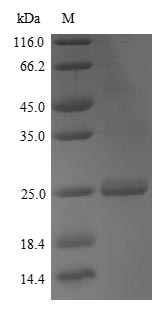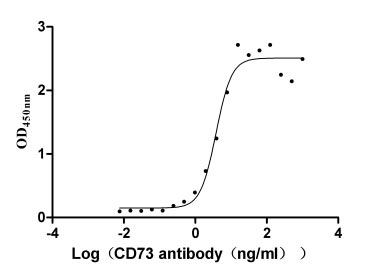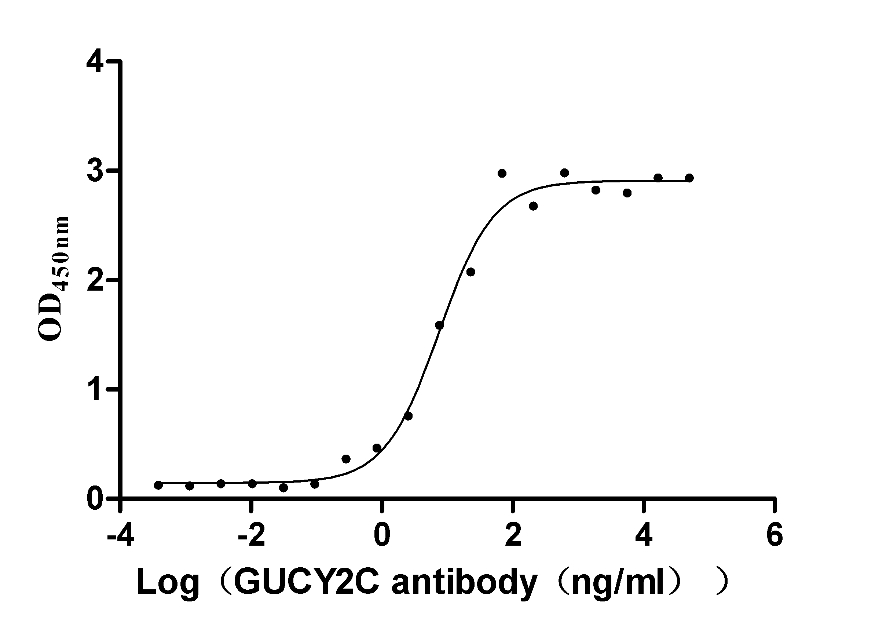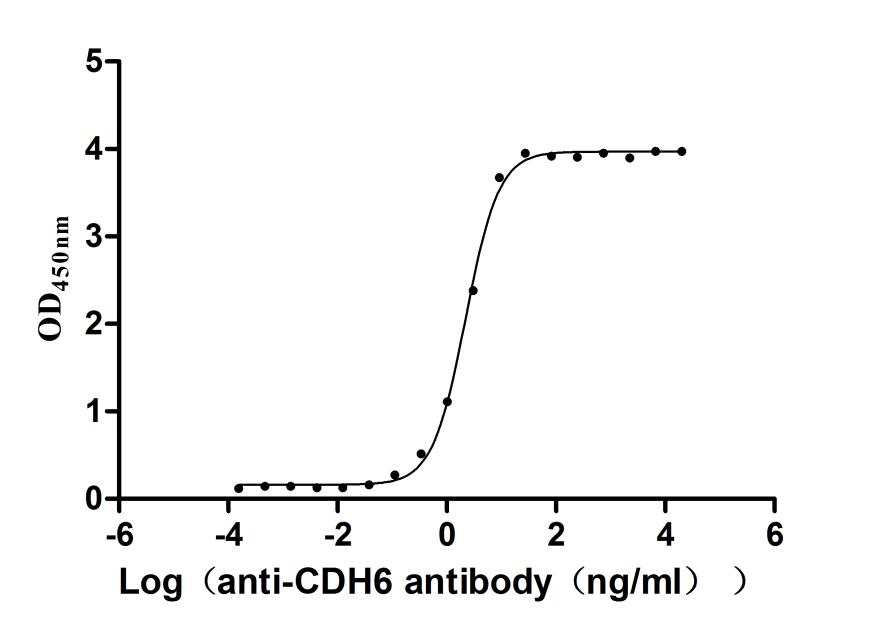Recombinant Mouse Apolipoprotein M (Apom)
In Stock-
中文名称:Recombinant Mouse Apolipoprotein M(Apom)
-
货号:CSB-YP001947MO
-
规格:¥1836
-
图片:
-
其他:
产品详情
-
纯度:Greater than 90% as determined by SDS-PAGE.
-
基因名:Apom
-
Uniprot No.:
-
别名:Apom; Ng20Apolipoprotein M; Apo-M; ApoM
-
种属:Mus musculus (Mouse)
-
蛋白长度:Full Length
-
来源:Yeast
-
分子量:23.3kDa
-
表达区域:1-190aa
-
氨基酸序列MFHQVWAALLSLYGLLFNSMNQCPEHSQLTALGMDDTETPEPHLGLWYFIAGAASTTEELATFDPVDNIVFNMAAGSAPRQLQLRATIRTKSGVCVPRKWTYRLTEGKGNMELRTEGRPDMKTDLFSSSCPGGIMLKETGQGYQRFLLYNRSPHPPEKCVEEFQSLTSCLDFKAFLVTPRNQEACPLSSK
Note: The complete sequence including tag sequence, target protein sequence and linker sequence could be provided upon request. -
蛋白标签:N-terminal 6xHis-tagged
-
产品提供形式:Liquid or Lyophilized powder
Note: We will preferentially ship the format that we have in stock, however, if you have any special requirement for the format, please remark your requirement when placing the order, we will prepare according to your demand. -
缓冲液:Tris-based buffer,50% glycerol
-
储存条件:Store at -20°C/-80°C upon receipt, aliquoting is necessary for mutiple use. Avoid repeated freeze-thaw cycles.
-
保质期:The shelf life is related to many factors, storage state, buffer ingredients, storage temperature and the stability of the protein itself.
Generally, the shelf life of liquid form is 6 months at -20°C/-80°C. The shelf life of lyophilized form is 12 months at -20°C/-80°C. -
货期:3-7 business days
-
注意事项:Repeated freezing and thawing is not recommended. Store working aliquots at 4°C for up to one week.
-
Datasheet & COA:Please contact us to get it.
相关产品
靶点详情
-
功能:Probably involved in lipid transport. Can bind sphingosine-1-phosphate, myristic acid, palmitic acid and stearic acid, retinol, all-trans-retinoic acid and 9-cis-retinoic acid.
-
基因功能参考文献:
- apoM-S1P-S1PR1 signaling might underlie the pathogenesis of ALI and apoM could have physiological benefits to alleviate LPS-induced ALI. PMID: 29260347
- These S1P-induced enhancements in growth factors and chemotactic cytokines in retinal pigment epithelium cells were significantly inhibited by ApoM treatment. Additionally, in vivo experiments using a laser-induced choroidal neovascularization (CNV) murine model demonstrated that intravitreal ApoM injection significantly reduced the progression of CNV formation. PMID: 29301231
- This study highlights the complexity of Apom/S1P in atherosclerosis and challenges the notion that the Apom/S1P complex is anti-atherogenic, at least in Apoe-deficient mice. PMID: 28866363
- This suggests that the autophagy dysfunction caused by the deficiency of ApoM is an important factor in hepatic steatosis (triglyceride accumulation). ApoM plays a key role in normal autophagy activity in the liver and thereby further regulates the metabolism of liver lipids, particularly triglycerides. PMID: 29288662
- HDL facilitates S1P efflux from erythrocytes by both apoM-dependent and apoM-independent mechanisms. Moreover, apoM facilitates tubular reabsorption of S1P from the urine, however, with no impact on S1P plasma concentrations. PMID: 24950692
- The study suggests that vascular leakage of albumin-sized particles in ApoM deficiency is S1P- and S1P1-dependent and this dependency exacerbates the response to inflammatory stimuli. PMID: 26956418
- apoM might facilitate the maintenance of CD4(+) T-lymphocytes or could modify the T-lymphocytes subgroups in murine spleen PMID: 26543853
- Upon immune stimulation, Apom(-/-) mice developed more severe experimental autoimmune encephalomyelitis, characterized by increased lymphocytes in the central nervous system and breakdown of the blood-brain barrier PMID: 26053123
- LDL receptor and ApoE have roles in the clearance of ApoM-associated sphingosine 1-phosphate PMID: 25505264
- ApoM augmented insulin secretion by maintaining the S1P concentration under both in vivo and in vitro conditions. PMID: 24814049
- The present data indicate that the plasma apo-M levels modulate the ability of plasma to mobilize cellular cholesterol, whereas apo-M has no major effect on the excretion of cholesterol into feces. PMID: 24046869
- ApoM can bind oxidized phospholipids, increasing the antioxidant effect of HDL. PMID: 22204862
- Results show that apoM, by delivering S1P to the S1P(1) receptor on endothelial cells, is a vasculoprotective constituent of HDL. PMID: 21606363
- After refolding from inclusion bodies, the crystal structure of apoM (reported here at 2.5 A resolution) displays a novel yet unprecedented seven-stranded beta-barrel structure. PMID: 20932978
- apoM mainly associates with HDL in normal mice but also with the pathologically increased lipoprotein fraction in genetically modified mice; decreased apoM levels in apoA-I-deficient mice suggest a connection between apoM and apoA-I metabolism. PMID: 15102887
- ApoM transcripts were detectable in mouse embryos from day 7.5 to day 18.5 PMID: 15147633
- in both liver and kidney, expression of apoM was significantly lower in leptin deficient ob/ob mice and in leptin-receptor deficient db/db mice than in control mice PMID: 15358114
- Overexpression of apoM in Ldlr(-/-) mice protected against atherosclerosis when the mice were challenged with a cholesterol-enriched diet. PMID: 15793583
- Megalin-mediated endocytosis in kidney proximal tubules prevents apoM excretion in the urine. PMID: 16099815
- Based on these results, we suggest that insulin regulates apoM synthesis in vivo and, therefore, that the reduction of apoM expression is a general phenomenon in diabetes models. PMID: 16516154
- In the setting of low density lipoprotein receptor deficiency, apoM-Tg mice with approximately 2-fold increased plasma apoM concentrations developed smaller atherosclerotic lesions than controls. PMID: 18006500
- Apolipoprotein M is a negative acute response protein that decreases during infection and inflammation PMID: 18054359
- Foxa2 activity increases plasma high density lipoprotein levels by regulating apolipoprotein M PMID: 18381283
显示更多
收起更多
-
亚细胞定位:Secreted.
-
蛋白家族:Calycin superfamily, Lipocalin family
-
组织特异性:Expressed by the liver; secreted in plasma.
-
数据库链接:
KEGG: mmu:55938
STRING: 10090.ENSMUSP00000025249
UniGene: Mm.2161
Most popular with customers
-
Recombinant Human Programmed cell death protein 1 (PDCD1), partial (Active)
Express system: Mammalian cell
Species: Homo sapiens (Human)
-
Recombinant Human 5'-nucleotidase (NT5E) (Active)
Express system: Mammalian cell
Species: Homo sapiens (Human)
-
Recombinant Human Heat-stable enterotoxin receptor (GUCY2C), partial (Active)
Express system: Mammalian cell
Species: Homo sapiens (Human)
-
Recombinant Human Signal transducer CD24 (CD24)-Nanoparticle (Active)
Express system: Mammalian cell
Species: Homo sapiens (Human)
-
Recombinant Human Cadherin-17 (CDH17), partial (Active)
Express system: Mammalian cell
Species: Homo sapiens (Human)
-
Recombinant Human CD81 antigen (CD81), partial (Active)
Express system: Mammalian cell
Species: Homo sapiens (Human)
-
Recombinant Human CD70 antigen (CD70), partial (Active)
Express system: Mammalian cell
Species: Homo sapiens (Human)
-
Recombinant Macaca fascicularis Cadherin 6(CDH6),partial (Active)
Express system: Mammalian cell
Species: Macaca fascicularis (Crab-eating macaque) (Cynomolgus monkey)





















